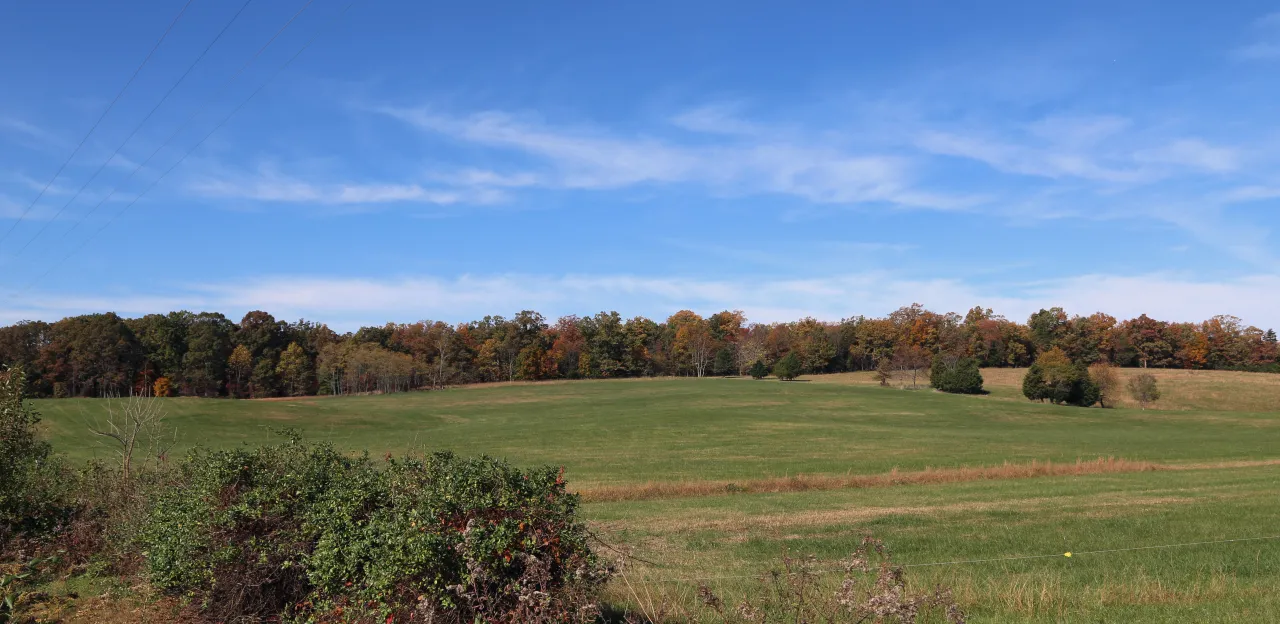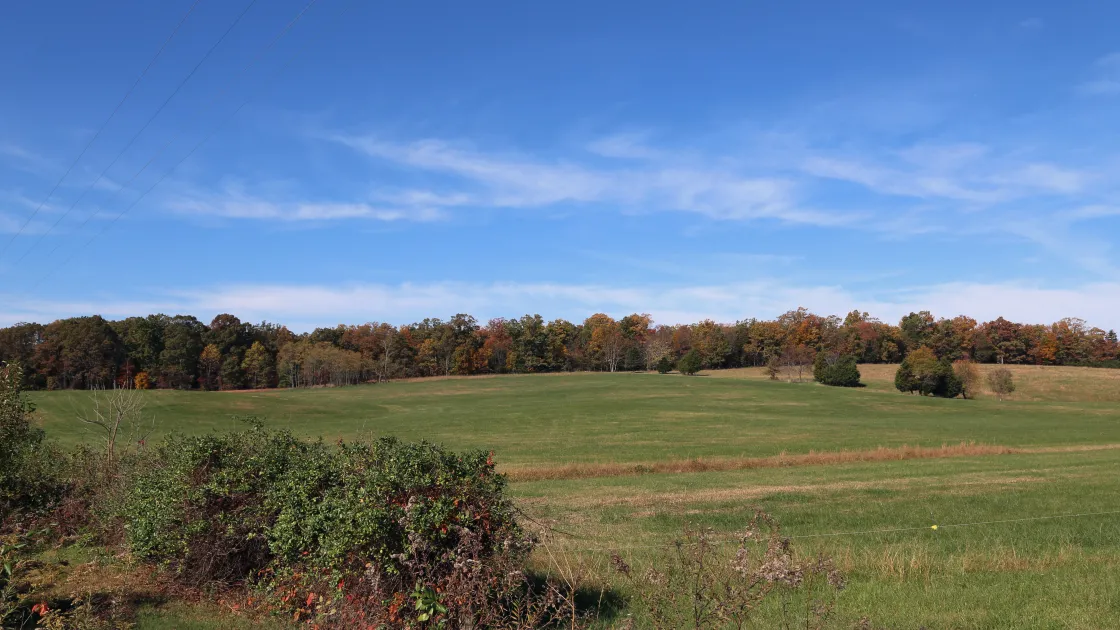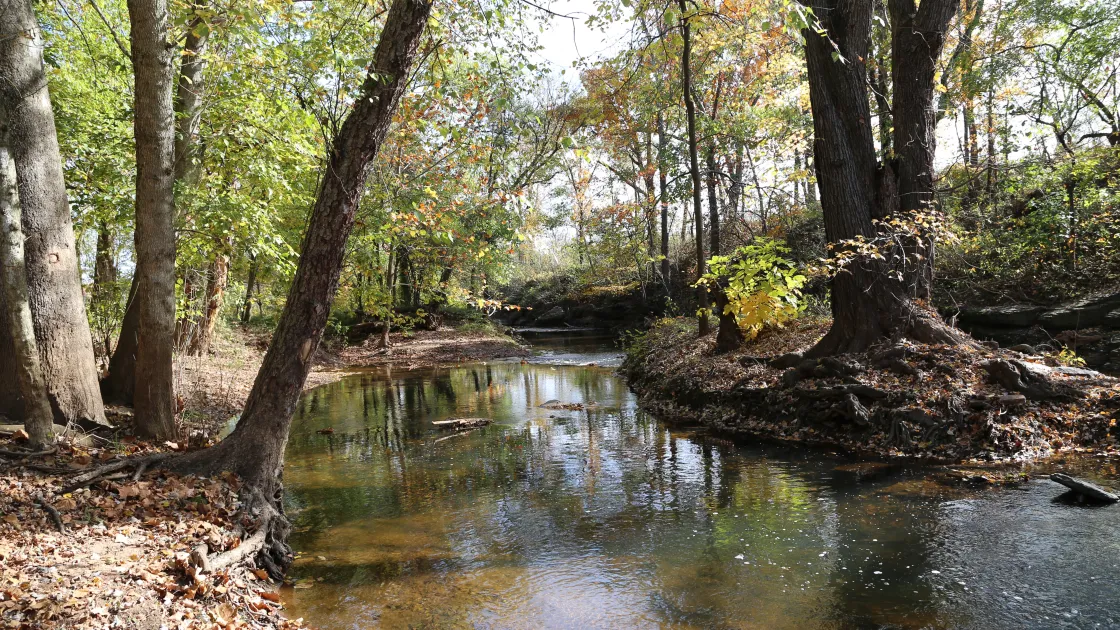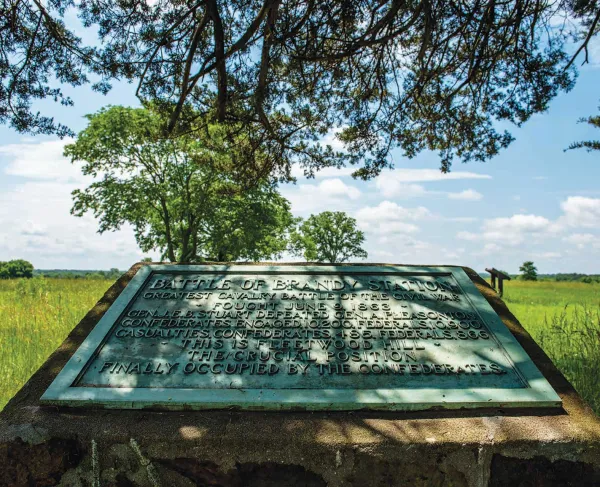Fight for Hansbrough Ridge: June 9, 1863

By Clark B. Hall

A union cavalry division supported by an infantry brigade—almost 6,000 soldiers— attacked at Beverly’s Ford on the early morning of June 9, 1863. Designated the “Right Wing,” this Union assaulting force was confronted by Confederate defenders on the Cunningham Farm (Civil War Trust property, largely), and heavy fighting broke out just south of the Rappahannock River.
To manage the hastily configured Confederate defense, General Jeb Stuart departed his Fleetwood Hill headquarters and rode forward to St. James Church. But as he galloped off, General Stuart ordered a regiment to remain behind in the village of Brandy Station and “be held in reserve.” This instinctive move by Jeb Stuart to protect his division’s rear sector proved prescient in the upcoming fight for Hansbrough Ridge, and as Brigade Commander Wade Hampton wrote, “The Second South Carolina…was detailed for this purpose…”
Left behind as “division reserve” in Brandy Station with about 220 troopers, Colonel Matthew C. Butler had no idea that an entire Federal cavalry division, the Union “Left Wing,”— almost 2,000 troopers—had crossed at Kelly’s Ford and was resolutely headed toward the village of Stevensburg, four miles south of Brandy Station. Soon notified by scouts that an advance enemy force was spotted in Stevensburg, Colonel Butler galloped his command down the Old Carolina Road. He now retained but 190 troopers as Colonel Butler detached 30 troopers to block adjacent Carrico’s Mill Road.
As leading elements of the 2nd South Carolina arrived in Stevensburg, a 6th Ohio Cavalry patrol was thrown back east of a prominent ridge that sharply rose just east of the hamlet.(1) Colonel Butler immediately decided to utilize Hansbrough Ridge as his defensive platform as this mile-long ridge blocked any enemy approach toward Stevensburg and Culpeper Court House, five miles beyond.
Arranging his forces north to south on the ridge, facing east, Butler sent Captain T.E. Screven with about 60 troopers to hold the northern section of the ridge; Colonel Butler secured the center of the ridge with an equal number; and Lt. Col. Frank Hampton held the southern section of the ridge with the remainder of the regiment. Hampton situated himself near the base of the Wishard Doggett house, then situated on the military crest of eastern Hansbrough Ridge.(2)
Alerted that Federal cavalry threatened his rear at Stevensburg, General Stuart dispatched the 4th Virginia Cavalry from near Brandy Station toward Stevensburg as tactical support for the 2nd South Carolina. Soon, about 600 troopers commanded by Colonel Williams C. Wickham galloped toward Hansbrough Ridge.
Finally arriving with his 2nd Cavalry Division just east of Hansbrough Ridge, Colonel Alfred N. Duffie probed the lofty enemy position by hurling mounted troopers over the flat plateau at the base of the ridge.(3) Utilizing Enfield rifles, the 2nd South Carolina threw back the assaulting Federals, and so far, the Hansbrough Ridge line remained solidly in control of affairs. Hidden just inside the wood-line atop the ridge, dismounted Rebel troopers continued to fire down into the faces of mounted Federal cavalry assembled at the eastern base of the ridge.
Colonel Duffie’s experienced battlefield gaze revealed to him that Hansbrough Ridge is at its lowest elevation near the southern terminus—and that a road (Kirtley’s) sliced through the ridge at this point. So in quick order, Colonel Duffie correctly deduced the enemy’s defensive front was far less formidable at “Hansbrough Gap.” He then decided upon a brigade assault against the Gap and ordered forward the 1st Massachusetts, 1st Rhode Island, and 6th Ohio Cavalry Regiments. Drawing sabers, the Yankees prepared to storm Hansbrough Gap.
Just now arriving on the scene, at the rear, the 4th Virginia Cavalry had utilized a cross-country byway (“Mountain Road”) from Norman’s Mill directly toward the Gap.(4) The timing of their arrival at the Gap could not possibly have been worse for the famed, “Black Horse cavalry.” Having urgently mounted his men after observing the Federals were about to charge his position in the roadway, there was nothing more Frank Hampton could do than put up a bold front and attempt to refuse the inevitable attack.
As the Yankees inaugurated their charge in the low ground east of the Doggett house, Confederate troopers on both sides of the roadway, high up on the ridge, poured plunging fire down into the flanks of the oncoming Blue columns. Just to the south of Kirtley’s, the 1st Massachusetts galloped in the lead; the 6th Ohio rode in the center, a bit further back; and the 1st Rhode Island proceeded west, on the right.

The Gap toward which the Federals charged was less than 100 yards wide and the compact geographical configuration ensured the fighting would be both personal and vicious. And it proved to be.
As the Bluecoats smashed into Lt. Col. Hampton’s force of about three-dozen troopers, Frank Hampton was shot in the abdomen and sabered across the face.(5) Confederate defenders fell precipitously rearward, with one Rebel officer observing Hampton’s “little force driven before the heavy columns of the enemy.” With triumphant sabers held high, Union cavalry raced hotly at the heels of retreating Rebels.
As the 4th Virginia Cavalry just started to emerge from the Mountain Road onto Kirtley’s Road, retreating 2nd South Carolinians hit headlong into the front of the 4th Virginia, impeding the tactical deployment of the 4th Virginia. Immediately thereafter, Federal cavalry smashed the left flank of Col. Wickham’s already confused, “column of fours.”
Overwhelmed and now panicked, the 4th Virginia Cavalry disintegrated into open chaos and instantly retreated to the west, where they were chased unceremoniously through the streets of Stevensburg. One 4th Virginian openly acknowledged, “…our regiment gave way with confusion.”
From his vantage point higher up on Hansbrough Ridge, Colonel Butler observed with horror the total collapse of his right flank at the Gap. He quickly ordered the center of his line to fall back to Norman’s Mill at Mountain Run. Soon afterwards he directed the left of his Hansbrough line to also withdraw to the north bank of Mountain Run, where a new defensive line could be established.
As Federal cavalry poured through the Gap and galloped over Hansbrough’s western slopes, Colonel Duffie glanced down and observed a dismounted Confederate battle line drawn up on the northern bank of Mountain Run. Cannon fire broke out as Colonel Duffie arranged his division for an attack over the little stream.
Colonel Matthew Butler was hit by a cannon ball and pulled to the rear. Colonel Wickham assumed overall command and prepared to confront the attack—one that was sure-to-come.
But, the attack did not result as the Left Wing Commander, General David Gregg, ordered Colonel Duffie to come to his aid at Fleetwood Hill, near Brandy Station. Colonel Duffie withdrew his command back through Hansbrough Gap and arrived near Brandy Station after the fight for Fleetwood Hill had already been decided!
Well after the Civil War—43 years later, in fact—former Lt. John Holtzman, 4th Virginia Cavalry, published a long letter about the fight for Hansbrough Ridge. Most presciently, Lt. Holtzman penned, “sometimes little things happen and produce great results….” He asserted, with justification, that the Confederate defense at Hansbrough Ridge and Mountain Run “went to work upon the Federals…and prevented Gen. Duffie from reaching Brandy by this route, and forcing him to go over one twice as far and consuming double the time…”
And without directly saying so, Lt. Holtzman’s insightful letter patently reveals the true historic significance of Hansbrough Ridge as this vital summit materially relates to the outcome of the largest cavalry battle of the Civil War—and the opening engagement of the Gettysburg Campaign.
Consider, please, that Hansbrough Ridge did not exist on June 9, 1863. Then assuming Hansbrough was not in place, where else south of Brandy Station would 190 troopers be able to hold off and delay the passage of 2,000 enemy men for well more than an hour? Where else but Hansbrough Ridge could a severely outnumbered blocking force ensure an opposing enemy column could not establish linkage with mates fighting for their lives on Fleetwood Hill, a mere four miles to the north?
No, the geographical presence of Hansbrough Ridge, and the exploitive, bold defense thereupon by the 2nd South Carolina Cavalry, resulted in an outcome that ensured a badly needed Union cavalry division would not participate in the winner-takes-all fight for Fleetwood Hill.
And any chance the Federal Cavalry Corps of the Army of the Potomac had to win the Battle of Brandy Station was certainly compromised at Hansbrough Ridge.
Notes:
(1) Hansbrough Ridge is named for Peter Hansbrough, a prosperous, Colonial-era landowner.
(2) The “Doggett House” survived the war but much damaged, was later torn down. The existing Doggett family cemetery is located just west of the house site, high atop Hansbrough Ridge.
(3) These first Yankee attacks toward Hansbrough took place over acreage that is now “Sandy Springs Farm.”
(4) The bed of the Mountain Road remains clearly discernible and can be observed at the western base of the ridge, near the Gap.
(5) Mortally wounded, Frank Hampton would be removed back to “Clover Hill,” the Jack Barbour home, a mile west of Stevensburg. He would die in this house, which still stands, barely.
We're on the verge of a moment that will define the future of battlefield preservation. With your help, we can save over 1,000 acres of critical Civil...





